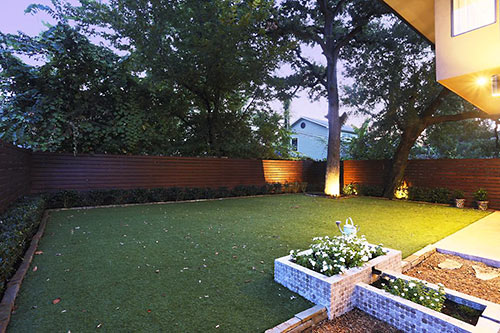
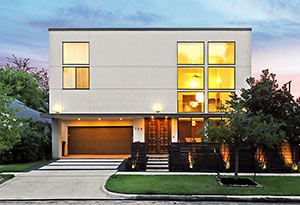 If you’re wondering what an expanse of fake grass is doing in the back yard of a $1.345 million home around the corner from Antidote, Premium Draught, and the Sonoma Wine Bar in the Heights, the architect of the 4-bedroom, 3,769-sq.-ft. structure has an answer for you: “The synthetic grass was the owner’s idea, which had my full support,” Cameron Armstrong tells Swamplot, after an email from a reader alerted us to the astroturfing issue. “It’s 100% recycled material, and significantly reduced our landscape irrigation needs,” the architect notes, “which gained the project some points during LEED certification (Silver).”
If you’re wondering what an expanse of fake grass is doing in the back yard of a $1.345 million home around the corner from Antidote, Premium Draught, and the Sonoma Wine Bar in the Heights, the architect of the 4-bedroom, 3,769-sq.-ft. structure has an answer for you: “The synthetic grass was the owner’s idea, which had my full support,” Cameron Armstrong tells Swamplot, after an email from a reader alerted us to the astroturfing issue. “It’s 100% recycled material, and significantly reduced our landscape irrigation needs,” the architect notes, “which gained the project some points during LEED certification (Silver).”
Ouch! Does learning that last bit give you a brain cramp? If so, you’re not alone:
***
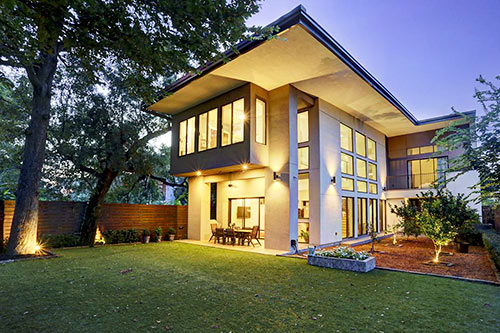
Armstrong, who documented the design and construction of the 2010 home on his website (where the project is labeled “Stude,” after the official neighborhood name), points to a couple of pics showing the “priceless” moment when the home’s LEED rater, Polly Ledvina, got her first look at the lawn samples. “I’m pretty sure she didn’t get into the LEED world in order to award sustainability points to fake grass,” Armstrong says.
The home at 734 E. 8th St. was first listed for sale at the beginning of August.
- 734 E. 8th St. [HAR]
- Progress Index 4 [Cameron Armstrong]


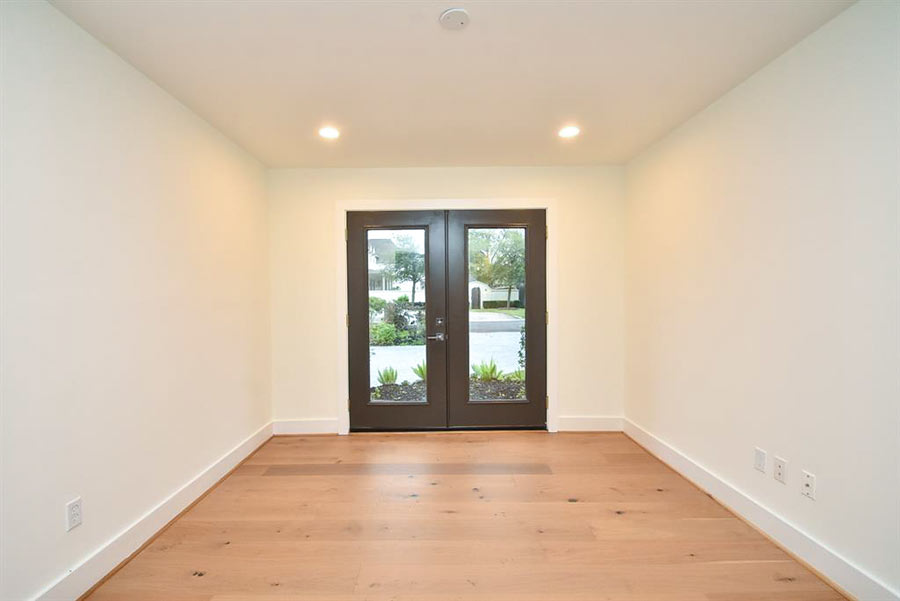

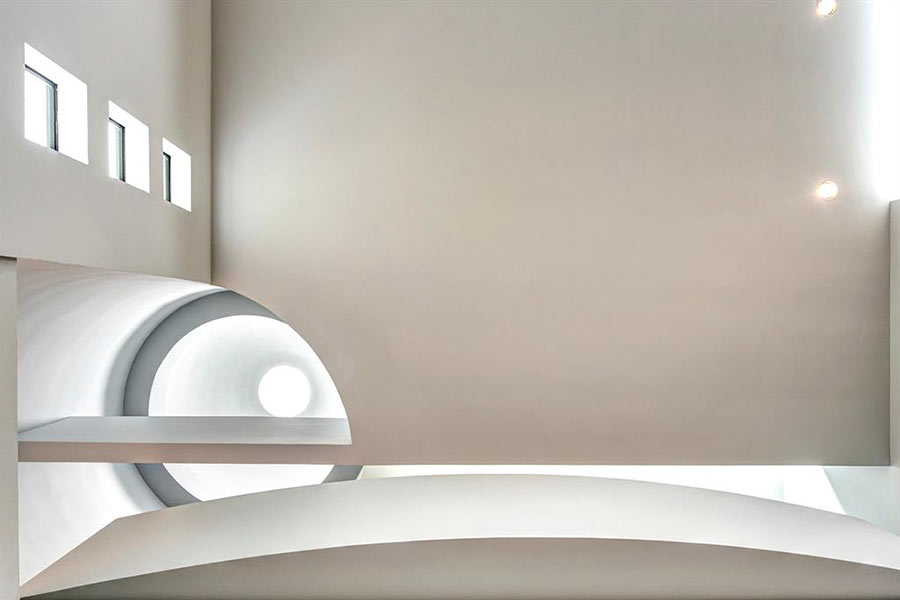
Your yard looks like synthetic shit, that will hold up about as well and all the water will run off into your neighbors yard or will pool in holes in the sunken fake turf, but here’s an LEED award your can hang on your wall, to show how proud you are of your AstroTurf lawn in bucolic Houston. It’s revolting to be honest, but yeah, at least he’s saving water I guess, still it looks like a put put course. I can see this lady who usually gets to survey all of these really cool modern homes for LEED Certification going out to his turf lawn he’s so proud of (like he reinvented the wheel) and saying, uh, I guess you get an award for not using water on your lawn? I get the feeling this guy thinks he invented AstroTurf. I can assure you in my neighborhood, people would revolt at the sight of this fake turf.
I mean, as a lazy but miserly person who doesn’t like spending money getting my lawn mowed, I don’t have a problem with it, but let’s call it what it is here… a few hundred square feet of fake grass ain’t gonna save the planet.
I love the fake grass and have installed it before. The new one looks a lot more realistic than it used to and has zero maintenance (unless you have a dog). You can actually use your back yard without fear of fireants, ticks, and other critters.
Fake is fine. It’s a different style; whatever.
What seems possibly problematic is that astroturf is waterproof, poor bug/bird/squirrel habitat, and non-photosynthesizing, so it isn’t performing some of the environmental tasks a lawn typically does. (And in Houston, it’s taxable too, since it’s impermeable.)
It is fully permeable, underneath it all is a mesh. That’s the reason it does not create puddles and is “self cleaning” by being able to wash away dirt into the ground like real grass.
@Sid–I’ll report them to the tax assessor in the morning, that way he can frame his newly assessed tax bill next to his LEED Certificate. I agree this really isn’t “Green” at all, there is nothing “natural” about this, it certainly doesn’t deserve an “award”.
Will someone that know about this stuff, describe to me what kind of materials and site preparation are used here? It seems like it would be easy to maintain but if a dog, kids or bunch of adults were to run around on this over and over how long before it would wear out? What happens when it rains, is it really impermeable? If it is impermeable, then does that mean it gets sealed around the edges and the water would then need to be controlled in a different manner? I’m not sure it is impermeable because how would those trees attain water except for the roots that extend to the adjacent properties. Does this require regular spraying of herbicides to control errant weeds?
Duston-
I plaid lacrosse in college in lots of areas that saw snow for most of the fall and winter. Multiple large colleges have turf fields that are under the HVAC domes like the Texans used. Having played on the stuff I can say the fake grass is pretty impressive. Stands up to cleats well too. In the summer Nebraska could drop the tent and just have outdoor turf, so water isn’t an issue either.
This stuff is a LONG way from astroturff or putt putt grass. I imagine for this use they likely did some level of compacted bank sand, overlayed with a geosythnetic to keep the sand from coming up then turf. It staples down somehow to keep from pulling up or wrinkling, at least the turf fields do.
No matter what the fake grass salesperson says fake grass is not dog pee friendly.
I’m not ordinarily one to rush to LEED’s defense. I think the US Green Building Council is a total racket and that their program frequently misses the point that environmental conservation is best achieved when one spends less money rather than more.
However…this is not a head-scratcher at all. If you install a permeable synthetic lawn made from recycled materials, you’re most likely saving money. Turf isn’t cheap. It’s not cheap to install and its not cheap to maintain. Environmentally, this does save water but more important is that it prevents mowing. Lawnmowers may have small engines, but they pollute very heavily. Lawns also create a heck of a lot of debris, and although most of that debris is biodegradable, hauling it away and processing it certainly isn’t without cost or consequence.
The other nice thing is, if you don’t make heavy use of a lawn (except to keep it maintained), then the artificial turf is pleasant to look at. It’s nicer than xeriscaping and easier than using native vegetation.
———
Shannon, threatening to report somebody to HCAD for using artificial turf is profoundly douchey.
West U grade school has a very large expanse of fake grass on its play ground. It has been installed for at least two years now and sees the bottoms of 1200 pairs of feet each year. It has held up spectacularly AND looks loads better than the dirt patch that was there before. I’m a big fan. I would rather have fake turf in my yard than to have it re-sod every third year due to drought/wear/ or just plain freakin’ St. Augustine which tends to thin out.
I have noticed many neighbors with this same turf in their yard here in West U. Most have it in the back yard. I don’t get the animosity towards it.
@shannon. You’ll report them to the tax assessor,,,,,”aren’t you the typical revolting Southampton busy body? Who cares what the guy put on his lawn.? The new buyer can rip it out if they don’t like it. It doesn’t look any worse than the xeriscape
In front of J.Blacks on Washington or any overgrown English Garden. Just be thankful the lawn is clean and manicured and place your outrage on something of true importance.
@TheNiche. I don’t think this is nicer than xeriscaping by a longshot. Cheaper sure, and easier to build/maintain, but a properly xeriscaped yard (not just slapping down some gravel over some black tarp) with Texas Wildflowers and whatnot is downright beautiful.
Astroturf is only slightly less “natural” than the non-native, ultra-fertilized grass most well-manicured lawns in Houston possess.
First of all, as a few others have said, synthetic turf has come a long way from “astroturf”, and most of you could not tell the real stuff from the fake at 20 feet away. And yes, it is permeable.
Second, it’s about time people wake up to all the BS that goes with LEED certification. I’m all for environmental sensitivity, but their scores are based upon adding points for some things, and subtracting points for others. Having annual flowers in front of your building subtracts points. Grass subtracts points. River rock over black plastic adds points. Not all landscapes are the same because not all climates are the same. Most of the landscaping rules for LEED seem to be written by people who live and work in California with it’s low rainfall, temperate climate.
Thanks for explaining this all!
I’m all for native plants and xeriscaping, but if you want something to walk on, for ‘lawn’ parties, nude twister, boules, or whatever, this seems like a good solution.
My sister has had some sort of field turf in her backyard in Denver for years. Their front yards are maintained by their HOA, and their backyard is relatively small, so it didn’t make a lot of sense to own lawn equipment or even have a service. This way they don’t have to worry about their yard turning into a muddy mess with snowmelt.
It’s not for me, but it makes a lot of sense. And The Niche’s points about how costly (ecologically) a typical grass lawn is in terms maintenance are spot on.
I’m glad other people have realized as well that LEED is a total scam. It’s not an official agency, it’s a private club for greeny weenies with no practical solutions only feel good nonsense. Unfortunately the LEED sticker has become a marketing ploy on it’s own and every new construction commercial wants one just so they can put it on their marketing materials.
===
LEED also gets ridiculous with more ratings, for example, you can only use ORGANIC cleaners for your everyday janitorial needs, you have to use different color RAGS for different surfaces, you have to have a written LONG TERM PLAN on how you’re planning to clean everything from toilets to the spot under the parking barrier. In my opinion, if it doesn’t smell like Chlorox, it ain’t clean.
i for one would love artificial grass and would love the fact that it doesn’t need to be watered extensively during the hottest months of the year, would reduce heavy pollution from lawn equipment and wouldn’t need to be fertilized with chemicals.
i think it’s well worth it’s green credentials, but yeah, i’ll never be able to afford a 1.35MM home much less a large sized yard in the inner loop to even matter.
I know people who use the stuff to as borders around their house or even around yard if they live out in the country. It obviously isnt natural and the critters know it. Things like snakes, bugs, etc will avoid crossing it.
Not much chance of growing any of your own food in a back yard like that.
While synthetic turf is permeable to a certain depth, the City of Houston counts it as impervious just like they do for gravel driveways. They treat both the same as concrete. It has to do with the compacted base material underneath that keeps the synthetic turf or gravel in place. This prevents water from going below that layer and merely sheds the water away the same way concrete does.
Next time you’re out walking your neighborhood, try playing ‘guess the grass’. You may be surprised to find that many of your neighbors have fake grass and you never noticed until taking off your sandals and giving it a good rub down with the bottom of your foot. I find I go out of my way to kick off my shoes and ‘sample’ my neighbors grass when it looks a little too manicured and beautiful. I’m always surprised when I touch it and it turns out to be fake – this stuff really does look real.
Some of the artificial turf is truly amazing. I’ve seen some installations that honestly have to be touched to know it’s not real. However, one client who had the stuff installed in a small courtyard forgot to tell his weekly ‘mow and blow’ crew not to set the overheated leaf blower down on it. Words were exchanged. Overheated words. The really good turf is scary expensive to install.
I have St. Augustine grass in my front and back yard. I have no sprinkler system. Houston gets @50 inches of rain a year. I will water it about 10-20 times in the summer, at best, and usually just the front as the back as more shade. One good down pour a week keeps it growing like a weed. I have an electric mulching mower. The clippings go right back into the soil. In the spring, I spend a day pulling weeds. Once the grass gets thick in the summer, weeds get choked out. I have never used weed killer. They key is to cut the grass to @3 inches and not cut it short. That keeps out the weeds and makes it more drought resistant. I may spread some organic fertilizer in the spring and aerate manually. Once a weed took over a spot that got dried out when I forgot to water during a snap of 100 deg days. I pulled out the weeds and replaced a 4 sq ft section with new sod. Cost me $7 at Grimes Grass. A year later, you cannot tell. Xeroscaping is better, but St. Augustine can be maintained with very minimal impact on the environment. Also, unlike fake grass, bugs, lizards, birds, worms and other critters will live in/off of grass. Nothing can live on fake turf, except for people who build ugly modern monstrosities in a neighborhood filled with historic bungalows.
I was wrong (as many people observed): modern fake grass can easily be made permeable. Interesting what Spencer wrote though, that Houston may still tax it because the ground underneath doesn’t handle water well. The things one learns.
@Old School
Thank you. I didn’t have to water my St. Aug even one time this summer. I only mow it every other weekend and keep the blades long. It takes care of itself otherwise.
Post a pic of what it looks like in a year after sitting in the sun all day, every day.
Wow, bet it’s not water permeable which can be a pain for your neighbors.